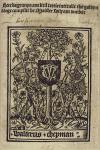Furtherreading
Other info : Bibliography
FURTHER READINGS ABOUT THE AUTHOR Bibliographies:
- William Geddie, A Bibliography of Middle Scots Poets, Scottish Text Society 61 (Edinburgh: Blackwood, 1912).
- Peter Heidtmann, "A Bibliography of Henryson, Dunbar, and Douglas, 1912-1968," Chaucer Review, 5 (Summer 1970): 75-82.
- Florence H. Ridley, "Middle Scots Writers," in A Manual of the Writings in Middle English 1050-1500, edited by A. E. Hartung, volume 4 (New Haven: Connecticut Academy of Arts and Sciences, 1973), pp. 1005-1060, 1204-1284.
- William Russell Aitken, "William Dunbar (1460?-1513?)," in Scottish Literature in English and Scots: A Guide to Information Sources, American Literature and World Literature in English, volume 37, edited by Aitken (Detroit: Gale Research Company, 1982), pp. 33-35.
- Jean—Jacques Blanchôt, "Dunbar and his Critics: A Critical Survey," in Scottish Language and Literature, Medieval and Renaissance, edited by Dietrich Strauss and Horst W. Drescher, Scottish Studies 4 (Frankfurt am Main: Lang, 1986), pp. 303-336.
- Walter Scheps and J. A. Looney, Middle Scots Poets: A Reference Guide to James I, Robert Henryson, William Dunbar and Gavin Douglas (Boston: Hall, 1986).
- J. W. Baxter, William Dunbar: A Biographical Study (Edinburgh: Oliver & Boyd, 1952).
- Priscilla Bawcutt, "Aspects of Dunbar's Imagery," in Chaucer and Middle English Studies in Honour of Rossell Hope Robbins (Kent, Ohio: Kent State University Press, 1974).
- Bawcutt, Dunbar the Maker (Oxford: Clarendon Press, 1992).
- Bawcutt, "William Dunbar and Gavin Douglas," in The History of Scottish Literature, volume 1, Origins to 1660, edited by R. D. S. Jack (Aberdeen: Aberdeen University Press, 1988).
- Eileen Bentsen and S. L. Sanderlin, "The Profits of Marriage in Late Medieval Scotland," Scottish Literary Journal, 12 (November 1985): 5-18.
- Lois A. Ebin, Illuminator, Makar, Vate: Visions of Poetry in the Fifteenth Century (Lincoln: University of Nebraska Press, 1988).
- Ebin, "The Theme of Poetry in Dunbar's 'Golden Targe,'" Chaucer Review, 7 (Fall 1972): 147-159.
- Elizabeth Eddy, "Sir Thopas and Sir Thomas Norny: Romance Parody in Chaucer and Dunbar," Review of English Studies, new series 22 (November 1971): 401-409.
- Deanna Delmar Evans, "Ambivalent Artifice in Dunbar's The Thrissill and the Rois," Studies in Scottish Literature, 22 (1987): 95-105.
- Evans, "Dunbar's Tretis: The Seven Deadly Sins in Carnivalesque Disguise," Neophilologus, 73 (January 1989): 130-141.
- Denton Fox, "The Chronology of William Dunbar," Philological Quarterly, 39 (October 1960): 413-425.
- Fox, "Dunbar's The Golden Targe," English Literary History, 26 (September 1959): 311-334.
- Fox, "The Scottish Chaucerians," in Chaucer & Chaucerians: Critical Studies in Middle English Literature, edited by D. S. Brewer (University: University of Alabama Press, 1966).
- Louise O. Fradenburg, City, Marriage, Tournament: Arts of Rule in Late Medieval Scotland (Madison: University of Wisconsin Press, 1991).
- David V. Harrington, "The 'wofull prisonnere' in Dunbar's Goldyn Targe," Studies in Scottish Literature, 22 (1987): 173-182.
- A. D. Hope, A Midsummer Eve's Dream: Variations on a Theme by William Dunbar (Canberra: Australian National University Press, 1970).
- Jack, "Dunbar and Lydgate," Studies in Scottish Literature, 8 (1970-1971): 215-227.
- A. M. Kinghorn, "Dunbar and Villon—A Comparison and a Contrast," Modern Language Review, 62 (April 1967): 195-208.
- C. S. Lewis, "The Close of the Middle Ages in Scotland," English Literature in the Sixteenth Century, Excluding Drama (Oxford: Clarendon Press, 1954).
- Roderick J. Lyall, "Moral Allegory in Dunbar's 'Golden Targe,'" Studies in Scottish Literature, 11 (1973): 47-65.
- Alasdair A. MacDonald, "Dunbar in Paraphrase," in A Day Estivall: Essays on Music, Poetry and History of Scotland and England and Poems Previously Unpublished in Honour of Helena Mennie Shire, edited by Alisoun Gardner-Medwin and Janet Hadley Williams (Aberdeen: Aberdeen University Press, 1990), pp. 112-123.
- Matthew P. McDiarmid, "The Early William Dunbar and his Poems," Scottish Historical Review, 59 (October 1980): 138-158.
- Steven R. McKenna, "Drama and Invective: Traditions in Dunbar's 'Fasternis Evin in Hell,'" Studies in Scottish Literature, 24 (1989): 129-141.
- Edwin Morgan, "Dunbar and the Language of Poetry," Essays in Criticism, 2 (January 1952): 138-158.
- Wilhelm F. H. Nicolaisen, "Line and Sentence in Dunbar's Poetry," in Bards & Makars, edited by Adam J. Aitken, McDiarmid, and Derick S. Thomson (Glasgow: Glasgow University Press, 1977), pp. 61-71.
- Joanne E. Norman, "Sources for the Grotesque in William Dunbar's 'Dance of the Sevin Deidly Synnis,'" Scottish Studies, 29 (1989): 55-75.
- Norman, "William Dunbar: Scottish Goliard," in Selected Essays on Scottish Language and Literature: A Festschrift in Honor of Allan H. MacLaine, edited by McKenna (Lewiston, N.Y.: Edwin Mellen Press, 1992).
- Roy Pearcy, "The Genre of William Dunbar's Tretis of the Tua Mariit Wemen and the Wedo," Speculum, 55 (January 1980): 58-74.
- Edmund Reiss, William Dunbar (Boston: G. K. Hall, 1979).
- Florence Ridley, "Scottish Transformations of Courtly Literature: William Dunbar and the Court of James IV," in The Expansion and Transformation of Courtly Literature, edited by N. B. Smith and J. T. Snow (Athens: University of Georgia Press, 1981), pp. 171-184.
- Ian Simpson Ross, William Dunbar (Leiden: E. J. Brill, 1981).
- Walter Scheps, "Chaucer and the Middle Scots Poets," Studies in Scottish Literature, 22 (1987): 44-59.
- Tom Scott, Dunbar: A Critical Exposition of the Poems (Edinburgh: Oliver & Boyd, 1966).
- Pamela K. Shaffer, "The Relationship of Syntax and Semantics in Three Poems of William Dunbar," Fifteenth-Century Studies, 12 (1987): 165-173.






